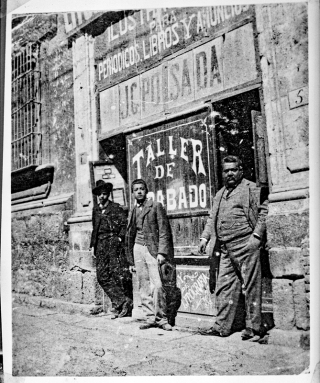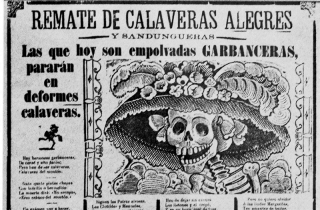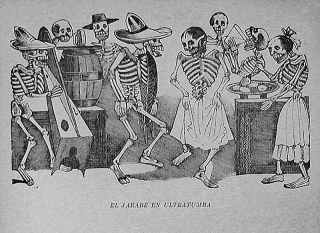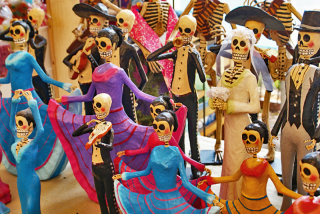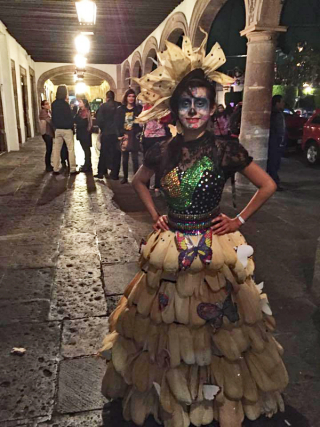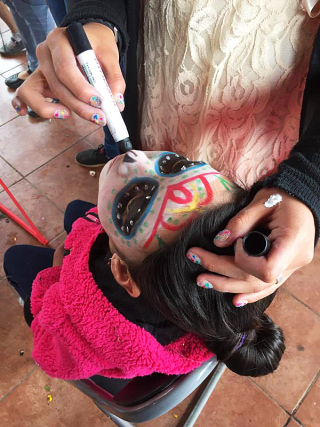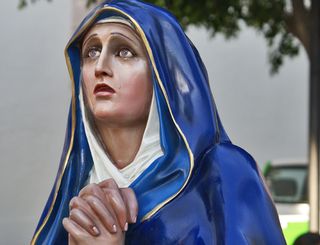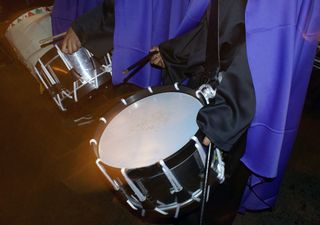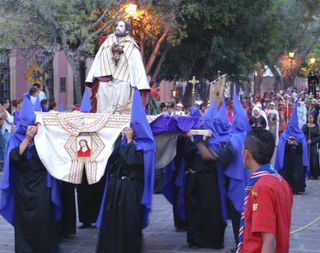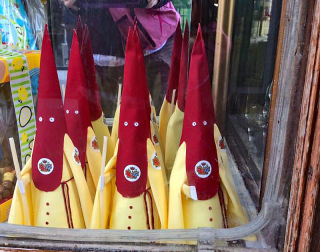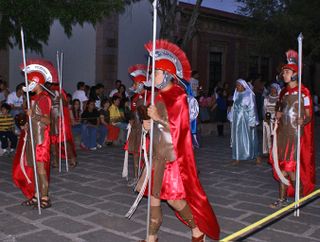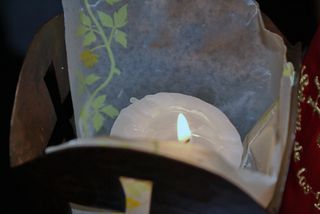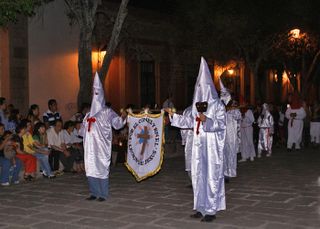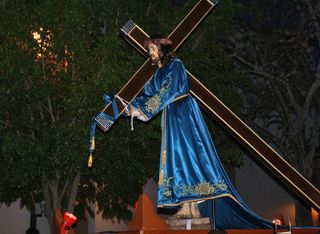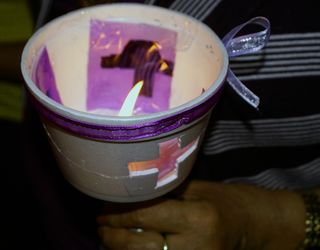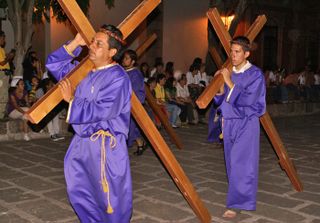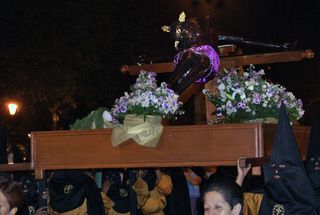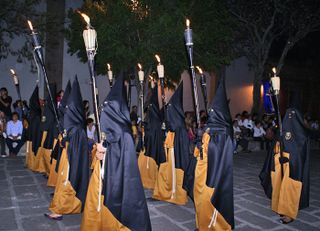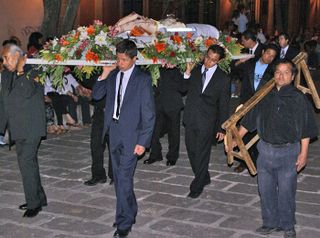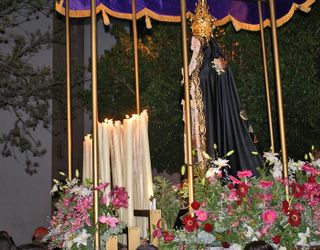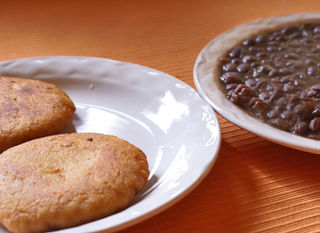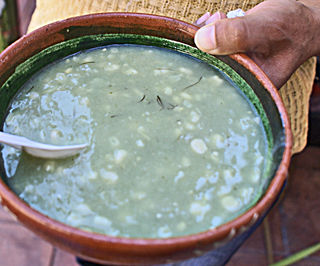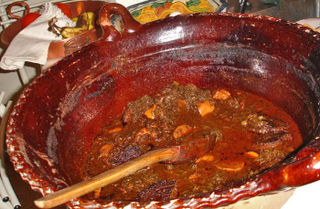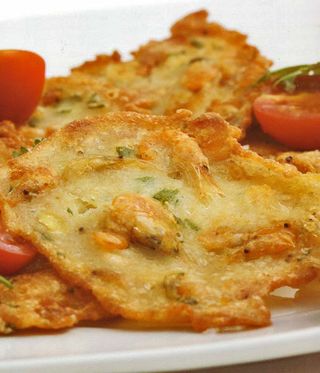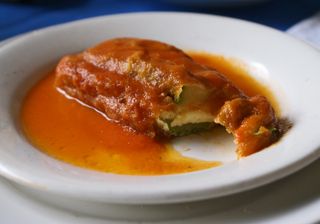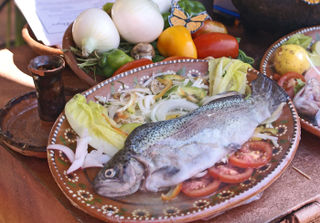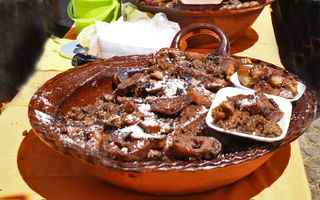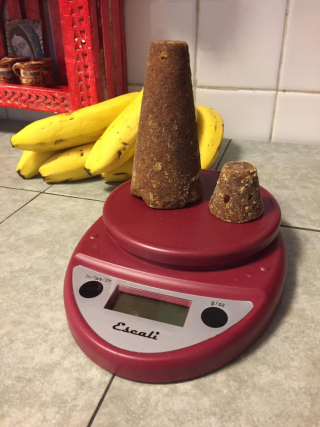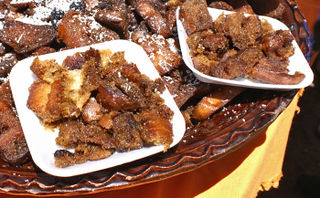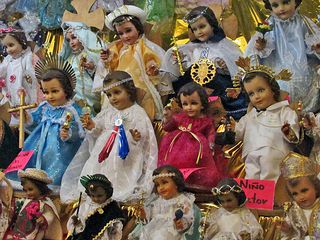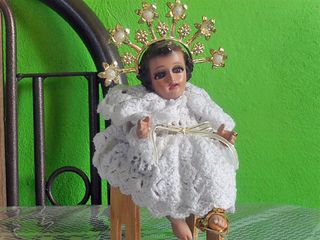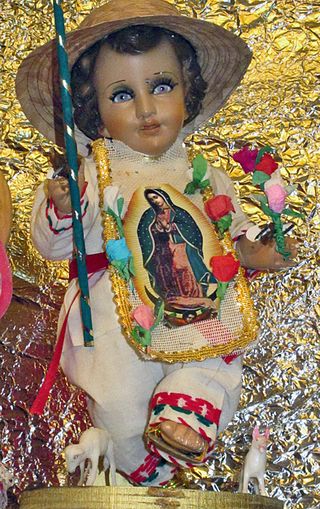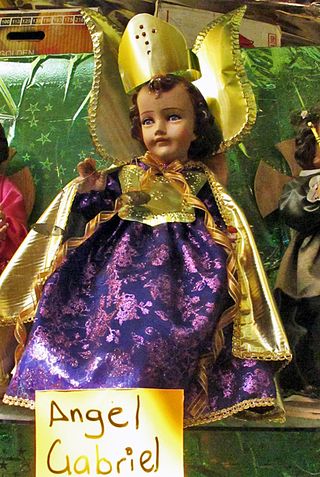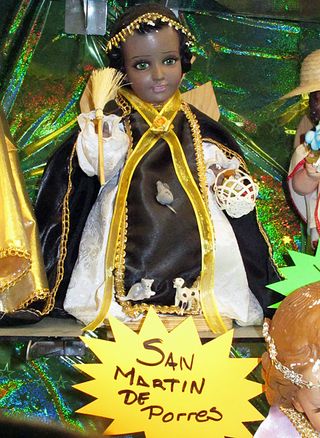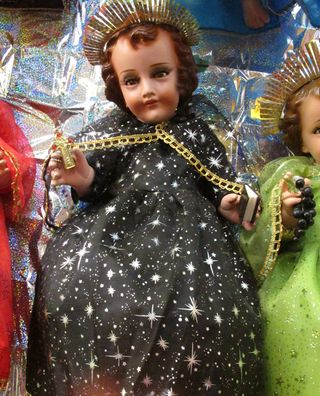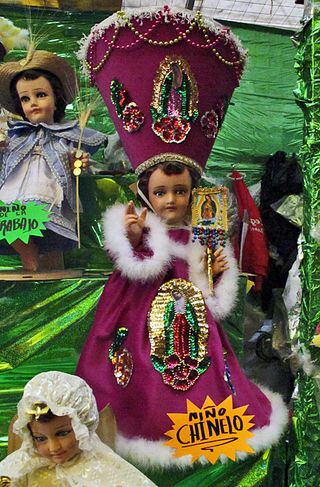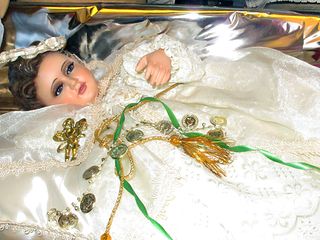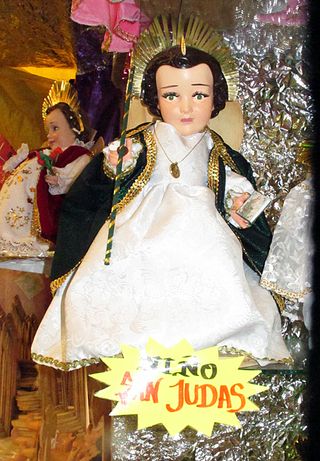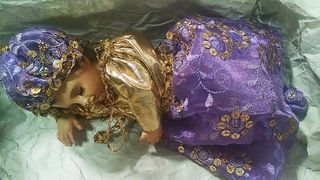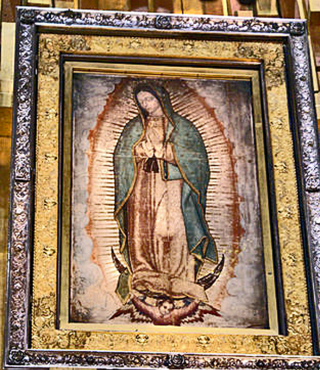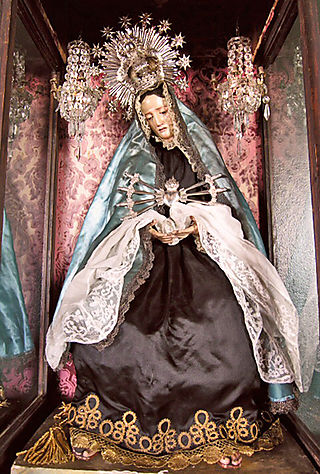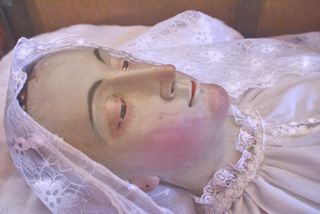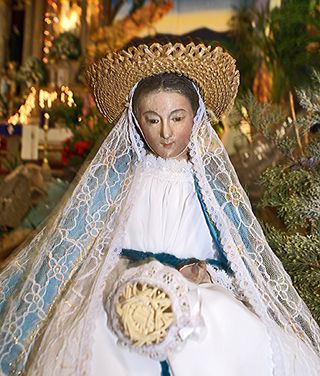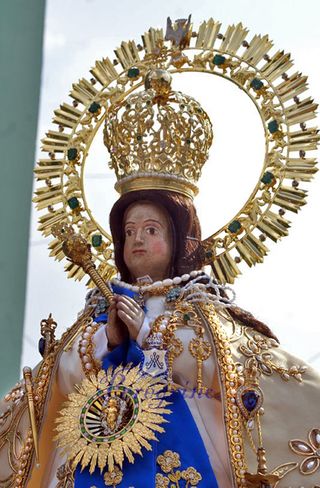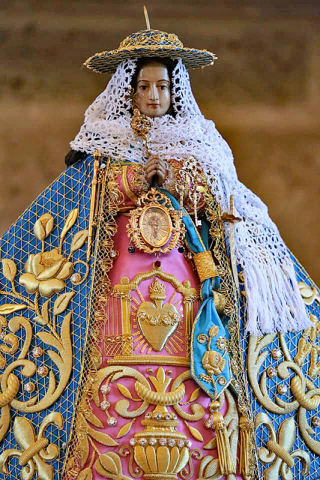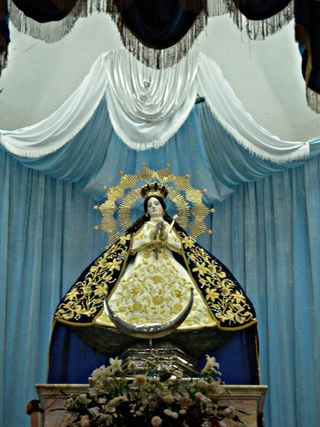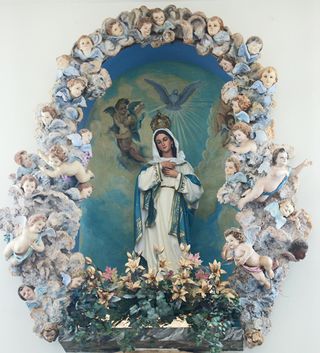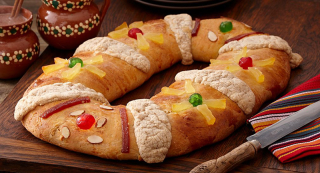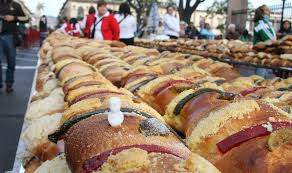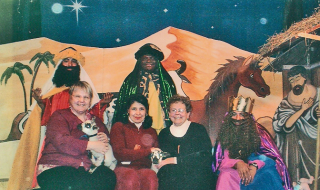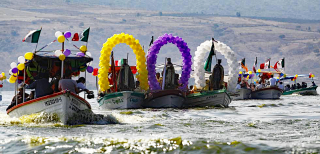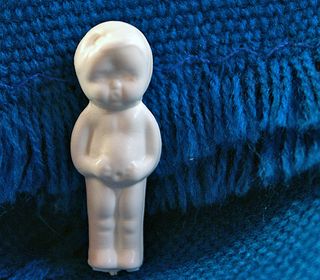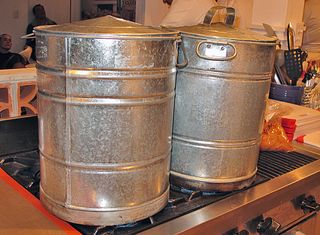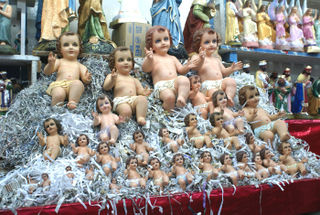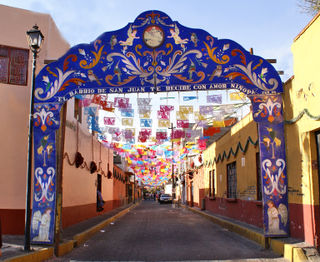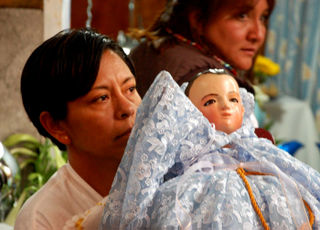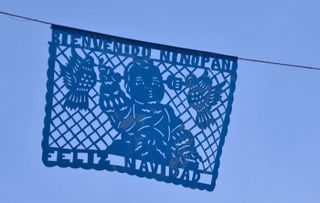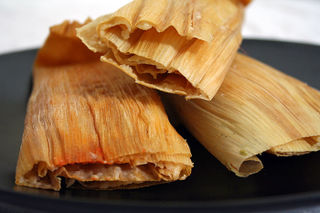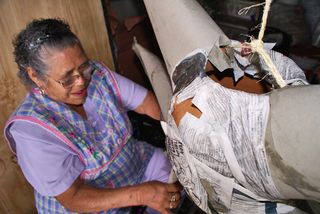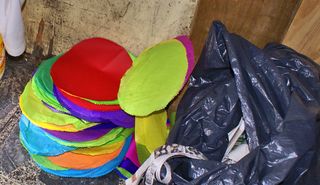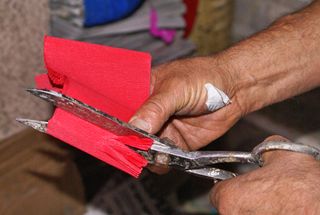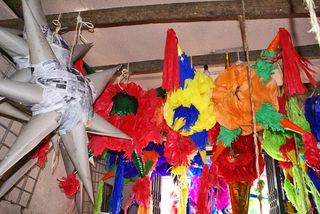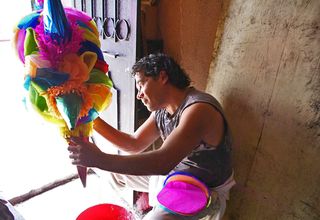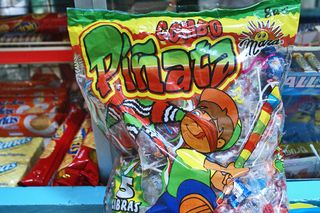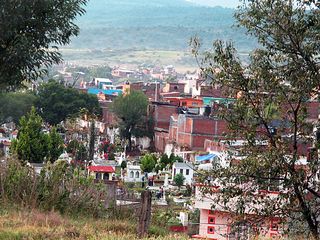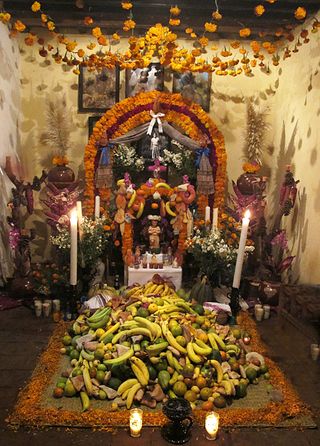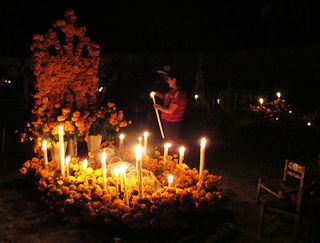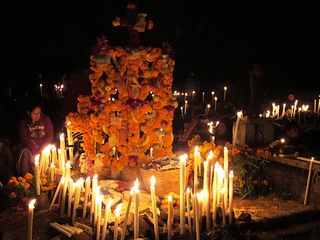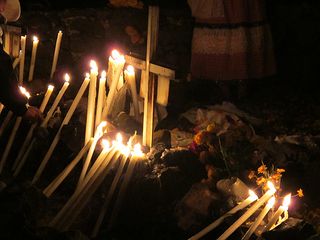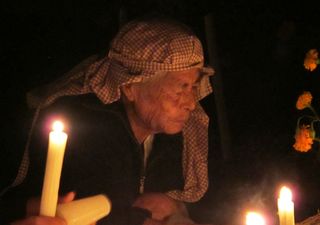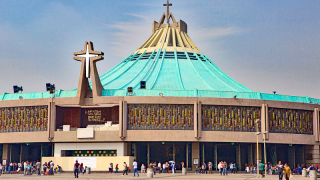
The Basílica de Nuestra Señora de Guadalupe (Our Lady of Guadalupe) in Mexico City. This newest Basílica was constructed between 1974 and 1976. It is the second most visited religious shrine in the western hemisphere–second only to the Vatican.
In 1982, Mexico Cooks! first visited La Morenita (a common nickname for Our Lady of Guadalupe) at her Basílica in Mexico City. Over the course of many years, I went back often. In 2008, I was taking a friend for her first visit to the shrine and I was practically bursting with the excitement of introducing her to the heart, the very soul, of Mexico. The extreme devotion demonstrated by the pilgrims to the Basílica, the depth of personal faith in La Reina de México (the Queen of México), and the juxtaposition of the sublime with the not-so-sublime makes the trip well worth repeating.
First on our list when many faithful visit Mexico City is always the Basílica of Our Lady of Guadalupe. Once our friends here discovered that we were going, every single person's first question was, "Van a la Villa?" ("Are you going to the Basílica)"
To each inquirer we grin and answer, "Of course! Vamos primero a echarle una visita a la virgencita." (The first thing we'll do is pay a visit to the little virgin!)
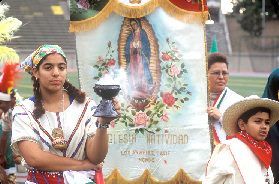
Devotional pilgrimages are an everyday occurrence at the Basílica.
The enormous Basílica of Nuestra Señora de Guadalupe in Mexico City is the most visited pilgrimage site in the Western Hemisphere. Its location, on the hill of Tepeyac, was a place of great sanctity long before the arrival of Christianity in the New World. In pre-Hispanic times, Tepeyac had been crowned with a temple dedicated to an earth and fertility goddess called Tonantzin, the Mother of the Gods. Tonantzin was a virgin goddess associated with the moon, like Our Lady of Guadalupe who usurped her shrine.
Nuestra Señora de Guadalupe is Mexico's patron virgin, the mother of us all, and her image adorns churches and altars, house fronts and interiors, taxis and buses, bull rings and gambling dens, restaurants and houses of ill repute. The shrine of Our Lady of Guadalupe, La Villa, is always a place of extraordinary vitality and celebration. On her major festival day, the anniversary of the apparition on December 12th, the atmosphere of devotion created by literally millions of pilgrims is truly electrifying.
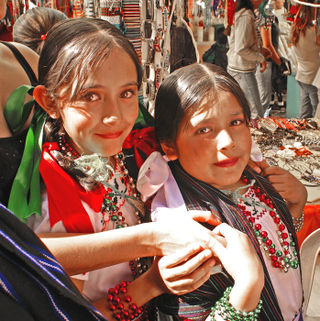
These young sisters are dressed as peregrinas indígenas (indigenous pilgrims) for el Día de Nuestra Señora de Guadalupe, celebrated every December 12.
The story of Our Lady's 1531 appearance in Mexico is familiar to every person who lives in this country.
The Tepeyac hill and shrine were important pilgrimage places for the nearby Mexica (later Aztec) capital city of Tenochtitlán. Following the conquest of Tenochtitlán by Hernan Cortez in 1521, the shrine was demolished, and the native people were forbidden to continue their pilgrimages to the sacred hill. The pagan practices had been considered to be devil worship for more than a thousand years in Christian Europe.
On Saturday, December 9, 1531, a recently baptized indigenous man named Juan Diego set out to see a doctor in a nearby town: his uncle was very sick and needed medicine. As he passed the pagan sacred hill of Tepeyac, he heard a voice calling to him. Climbing the hill, he saw on the summit a young woman who seemed to be no more than fourteen years old, standing in a golden mist.
Revealing herself as the "ever-virgin Holy Mary, Mother of God" (so the Christian telling of the story goes), she told Juan Diego not to be afraid. Her words? "Am I not here, am I not your mother?" She instructed him to go to the local bishop and tell him that she wished a church for her son to be built on the hill. He told her about his uncle's illness; she said, "Don't worry about your uncle, I'll take care of him. Please go to the bishop." Juan did as he was instructed, but the bishop's staff refused to let him into the office.
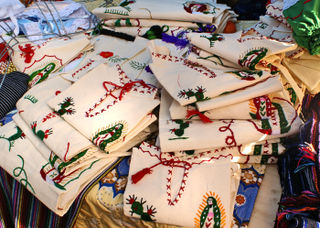
Typical children's costumes to be worn in processions for the Feast of Our Lady of Guadalupe.
On his way home, Juan climbed the sacred hill and again saw the apparition. He reported his failure to see the bishop. The Virgin told him to return to the bishop the next day. This time the bishop's staff listened more attentively to Juan's message from Mary. They were still skeptical, however, and so asked him to go get a sign from Mary that would prove who she was.
Two days later Juan went again to Tepeyac and, when he again met Mary, she told him to climb the hill and pick the roses that were growing there. Juan climbed the hill with misgivings. It was the dead of winter, and flowers could not possibly be growing on the rocky, cold and frosty mountain. At the summit, Juan found a profusion of roses, an armful of which he gathered and wrapped in his tilma (a garment similar to a poncho). Arranging the roses, Mary instructed Juan to take the tilma-encased bundle to the bishop, for this would be her sign.
When the bishop unrolled the tilma, he was astounded by the presence of the flowers. They were roses that grew only in Seville, Spain–where he had lived. But more truly miraculous was the image that had mysteriously appeared on Juan Diego's tilma. The image showed the young woman, her head lowered demurely. Wearing a starry blue mantle and flowing gown, she stood upon a crescent moon. The bishop was convinced that Mary had indeed appeared to Juan Diego and soon thereafter the bishop began construction of the original church devoted to her honor.
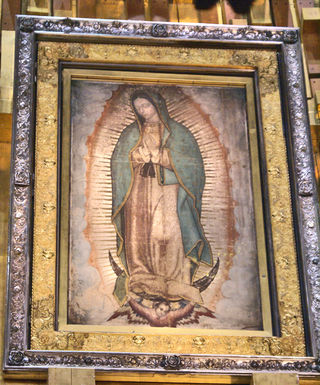
The original tilma worn by Juan Diego still hangs above the altar in the Basílica. Venerated by millions of pilgrims, the maguey cactus fiber tilma shows no wear after 486 years.
News of the miraculous apparition of the Virgin's image on a peasant's tilma spread rapidly throughout Mexico. Indians by the thousands came from hundreds of kilometers away to see the image, now hanging above the altar in the new church. They learned that the mother of the Christian God had appeared to one of their own kind and spoken to him in his native language. The miraculous image was to have a powerful influence on the advancement of the Church's mission in Mexico. In only seven years, from 1532 to 1538, more than eight million Indians were converted to Christianity.
The shrine, rebuilt several times over the centuries, is today a great Basílica with a capacity for 50,000 pilgrims.
Juan Diego's tilma is preserved behind bulletproof glass and hangs twenty-five feet above the main altar in the basilica. For more than 485 years the colors of the image have remained as bright as if they were painted yesterday, despite being exposed for more than 100 years following the apparition to humidity, smoke from church candles, and airborne salts.
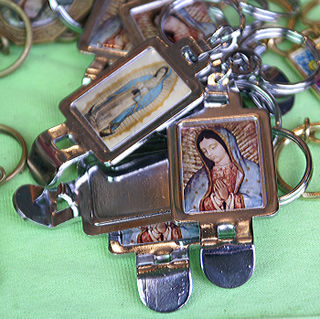
From the sublime to the not-so-sublime: these key ring-bottle openers for sale in the trinket bazaar outside the Basílica bear various images of Nuestra Señora de Guadalupe.
The coarsely-woven cactus cloth of the tilma, a cloth considered to have a life expectancy of about 40 years, still shows no evidence of decay. Astronomers have concluded that the 46 stars on her gown coincide with the position of the constellations in the heavens at the time of the winter solstice in 1531. Scientists have investigated the nature of the image and have been left with nothing more than evidence of the mystery of a miracle. The dyes forming her portrait have no base in the elements known to science.
The origin of the name Guadalupe has always been a matter of controversy. It is believed that the name came about because of the translation from Nahuatl to Spanish of the words used by the Virgin during the apparition. It is believed that she used the Nahuatl word coatlaxopeuh which is pronounced "koh-ah-tlah-SUH-peh" and sounds remarkably like the Spanish word Guadalupe. 'Coa' means serpent, 'tla' can be interpreted as "the", while 'xopeuh' means to crush or stamp out. This version of the origin would indicate that Mary must have called herself "she who crushes the serpent," a Christian New Testament reference as well as a a reference to the Mexica's mythical god Quetzacóatl, the plumed serpent.
That February, we took the Metrobús to La Villa, a journey of about an hour from the neighborhood called La Condesa, where we were staying with friends, to the Basílica in the far northern part of the city. The Metrobús, Mexico City's marvelous above-ground rapid transit system, left us just two blocks from the Basílica.
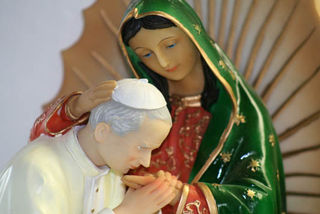
Pope John Paul II made five official visits to Mexico. To many Mexicans, he continues to be the true Pope, Mexico's Pope. This image of Pope John Paul II, showing him protected by and devoted to Nuestra Señora de Guadalupe, is found in both pictures and figures. It is still displayed in many Mexican homes.
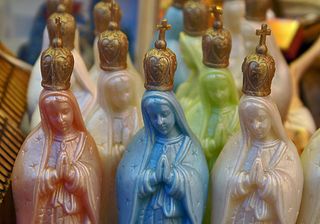
Holy water bottles in the image of Our Lady of Guadalupe, available from vendors' booths around the Basílica.
The street and the bridge to the Basílica are filled chock-a-block with booths selling souvenirs of La Villa. Everything that you can think of (and plenty you would never think of) is available: piles of t-shirts with the image of the Virgin of Guadalupe and that of Juan Diego, CDs of songs devoted to her, bandanna-like scarves with her portrait, eerie green glow-in-the-dark figurines of her, key chains shaped like the Basílica, statues of La Virgencita in every size and quality, holy water containers that look like her in pink, blue, green, and pearly white plastic, religious-theme jewelry and rosaries that smell of rose petals, snow globes with tiny statues of La Guadalupana and the kneeling Juan Diego that are dusted with stars when the globes are shaken.
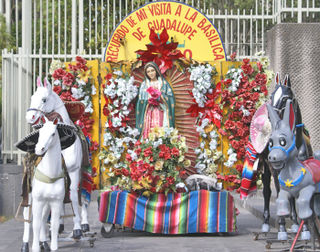
In front of the Basílica, you can have your picture taken next to her image and with a variety of horses. The caption on the yellow sign reads, "A Memento of My Visit to the Basílica of Guadalupe".
There are booths selling freshly arranged flowers for pilgrims to carry to the shrine. There are booths selling soft drinks, tacos, and candy. Ice cream vendors hawk paletas (popsicles). Hordes of children offer chicles (chewing gum) for sale. We were jostled and pushed as the crowd grew denser near the Basílica.
Is it tacky? Yes, without a doubt. Is it wonderful? Yes, without a doubt. It's the very juxtaposition of the tourist tchotchkes with the sublime message of the heavens that explains so much about Mexico and its duality. We needed to buy several recuerdos (mementos) for our friends in the United States, but we were hard-pressed to decide what to choose. Some pilgrims buy before going into the Basílica so that their recuerdos can be blessed by a priest, but we decided to wait until after visiting the Virgin to do our shopping. When we finished shopping, we discovered that a priest was stationed in a nearby booth to bless late purchases.
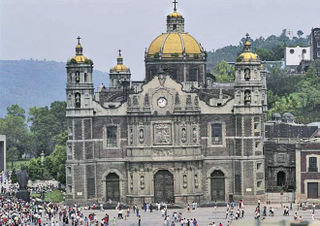
The 16th Century Basílica is sinking into Mexico City's shifting subsoil. The new Basílica is built in the same plaza.
The present church was constructed on the site of the 16th-century first shrine to Our Lady of Guadalupe. It was replaced by the shrine that was finished in 1709, called the Old Basílica. When the Old Basílica became dangerous due to the sinking of its foundations, a modern structure called the New Basílica was built on the same property. The original image of the Virgin of Guadalupe is now housed above the altar in this New Basílica.
Built between 1974 and 1976, the new Basílica was designed by architect Pedro Ramírez Vásquez. Its seven front doors are an allusion to the seven gates of Celestial Jerusalem referred to by Christ. It has a circular floor plan so that the image of the Virgin can be seen from any point within the building. An empty crucifix symbolizes Christ's resurrection. The choir is located between the altar and the churchgoers to indicate that it, too, is part of the group of the faithful. To the sides are the chapels of the Santísimo Sacramento (the Blessed Sacrament) and of Saint Joseph.
That February, on an ordinary day at the beginning of Lent, we entered the Basílica as one Mass was ending and another was beginning. Thirty Masses are often celebrated during the course of any day. Pilgrims pour in to place baskets of flowers on the rail around the altar. People filled the pews and were standing 10-deep at the back of the church. There were lines of people waiting to be heard in the many confessionals.
We stood for a bit and listened to what the priest was saying. "La misa de once ya se terminó. Decidimos celebrar otra misa ahora a las doce por tanta gente que ha llegado, por tanta fe que se demuestra" ("The eleven o'clock Mass is over. We have decided to celebrate another Mass at 12 o'clock because so many people have arrived, because of so much faith being demonstrated.")
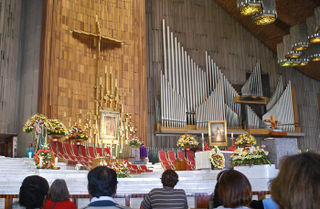
Priests celebrate as many as 30 Masses every day of the year.
Making our way through the crowd, we walked down a ramp into the area below and behind the altar. Three moving sidewalks bore crowds of pilgrims past the gold-framed tilma. Tears flowed down the cheeks of some; others made the sign of the cross as they passed, and one woman held her year-old baby up high toward the Virgin. Most people moved from one of the moving sidewalks to another in order to be able to have a longer visit with the Mother of Mexico.
When I first visited the Basílica 35 years ago, there were only two moving sidewalks. Behind them was space for the faithful to stand and reflect or pray for a few minutes. Now there are three moving walkways. The constant crush of visitors required that the quiet space be devoted to movement rather than reflection and rest.
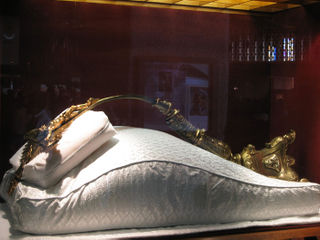
We walked to the back of the Basílica to look at a large bronze crucifix exhibited in a glass case. The crucifix, approximately three feet high, is bent backward in a deep arch and lies across a large cushion. According to the placard and the photos from the era, in 1921 a bouquet of flowers was placed directly on the altar of the Old Basílica beneath the framed tilma. It was later discovered that the floral arrangement was left at the altar by an anarchist who had placed a powerful dynamite bomb among the flowers. When the bomb detonated, the altar crucifix was bent nearly double and large portions of the marble altar were destroyed. Nevertheless, no harm came to the tilma and legend has it that the crucified Son protected his Mother from the bomb.
After a while, we reluctantly left the Basílica. With a long backward glance at the tilma, we stepped out into the brilliantly sunny Mexico City afternoon. The throngs in the Basílica atrium still pressed forward to visit the shrine.
We stopped in some of the enclosed shops at sidewalk level and then continued over the bridge through the booths of mementos. After we bought small gifts, the priest on duty blessed them for us and we moved away to hail a taxi. My heart was still in the Basílica, with our Mother.

Take your pick: hundreds of statues of Nuestra Señora de Guadalupe await you in the shops outside the Basílica.
The Feast of Our Lady of Guadalupe falls on December 12 each year. Think about her just for a moment as you go about your day. After all, she's the Queen of Mexico and the Empress of the Americas.
How to get there once you're in Mexico City:
- From the Centro Histórico (Historic Downtown) take Metro Line 3 at Hidalgo and transfer to Line 6 at Deportivo 18 de Marzo. Go to the next station, La Villa Basílica. Then walk north two busy blocks until reaching the square.
- Take the Line 1 Metrobús (Indios Verdes) north to the station Deportivo 18 de marzo. Go down the stairs, head left half a block to the corner, turn right to cross the street, and walk two blocks to the right until you get to the Basílica.
- From the Hidalgo Metro station take a pesero (microbus) to La Villa.
- From Zona Rosa take a pesero along Paseo de la Reforma, north to the stop nearest the Basílica.
- Or take an Uber from your hotel, wherever it is in the city. Tell the driver, "A La Villa, por favor. Vamos a echarle una visita a la Virgencita." ("To the Basílica, please. We're going to make a visit to the little Virgin.")
Looking for a tailored-to-your-interests specialized tour in Mexico? Click here: Tours.

